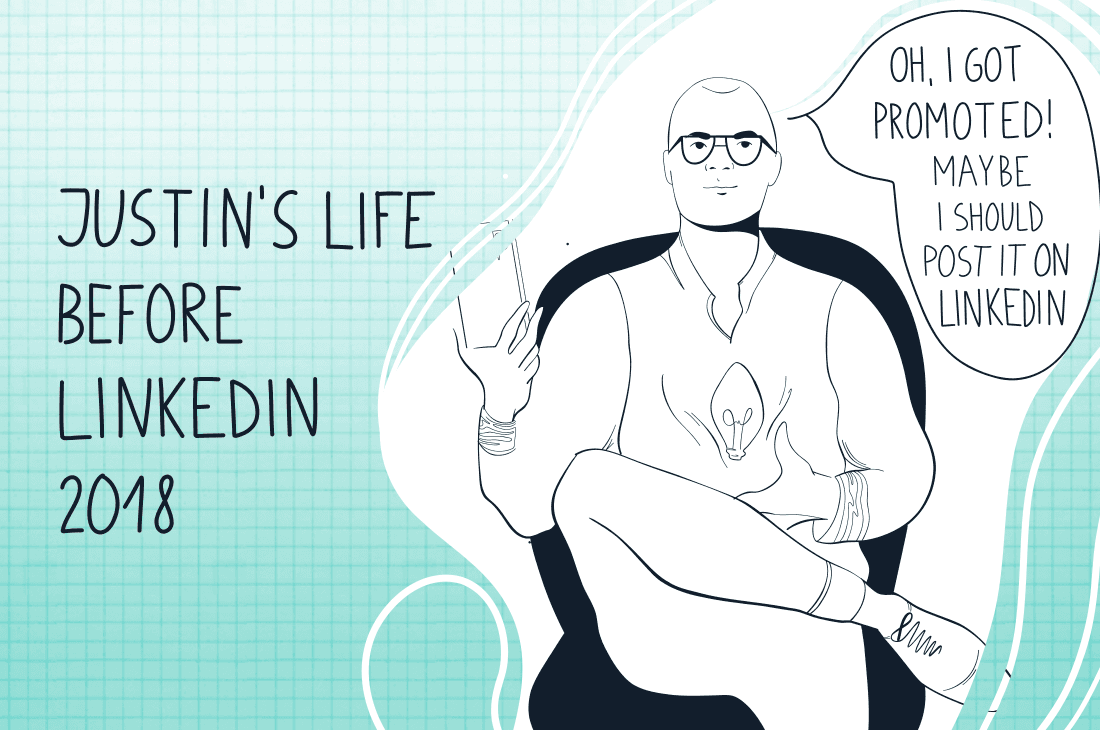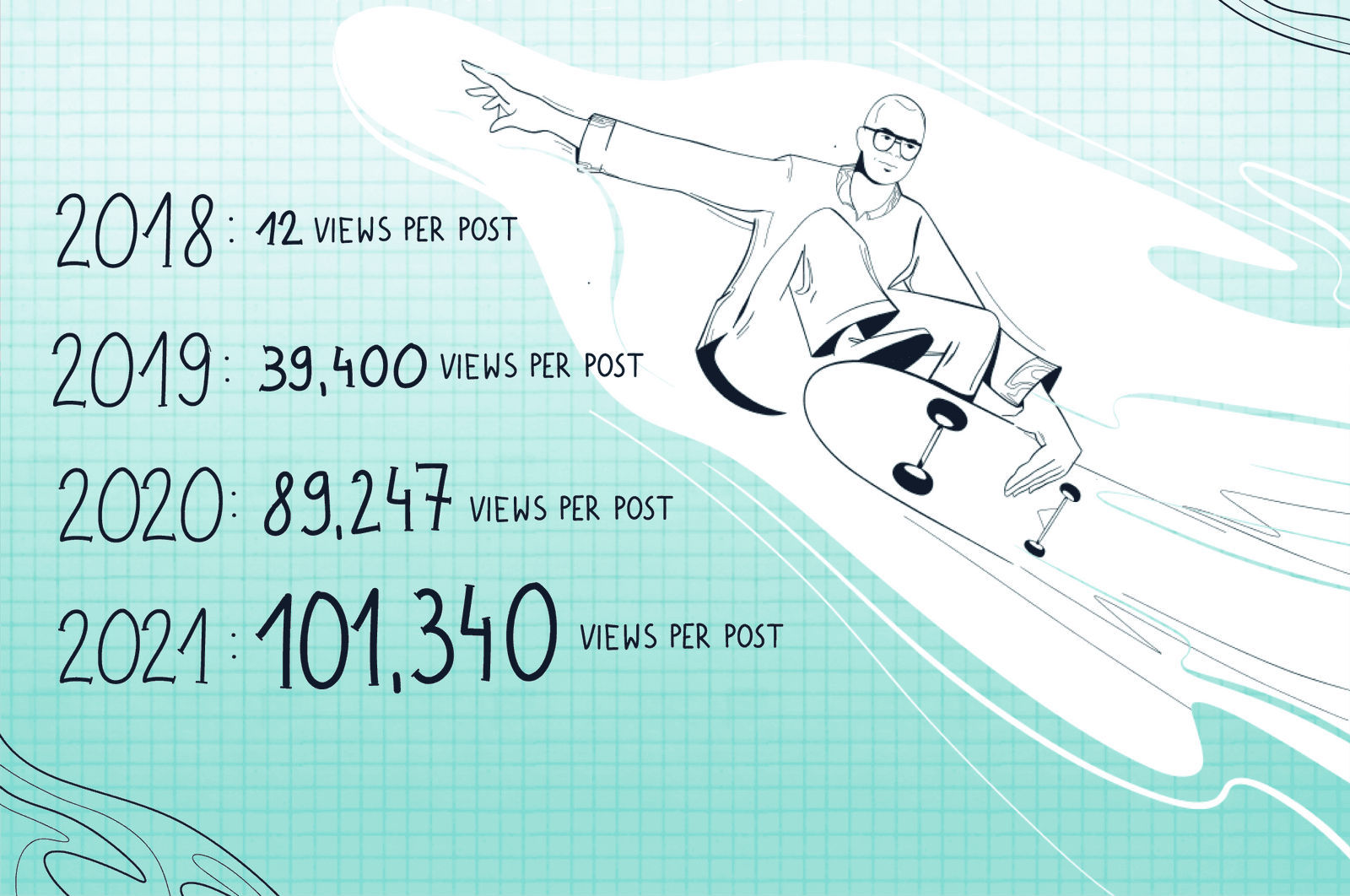Justin Welsh
This interview dates back to 2021, so a few details might be outdated. Either way we hope you enjoy the read :)
Personal Branding for Solopreneurs on LinkedIn with Justin Welsh
The story of Justin is for you if you want a sneak peek into what building a personal brand can do.
We sat down with Justin Welsh to understand how he took control of his personal brand and built himself a life very different from his previous 9-5 lifestyle.
A new life where Justin went from 0 to 150,000 views per post on LinkedIn while building a massive audience of 440,000 people that is still growing at a steady pace.
Justin's story is proof that when you are intentional and consistent with your content and your brand on LinkedIn, you can change the trajectory of your career and your life.
Making a change. Introducing LinkedIn.
What began as a career in sales and a barely-there presence on LinkedIn, has evolved into a movement. A movement of personal branding that Justin is at the forefront of. He has now broken away from the 9-5 job, founded JW Advisory and just recently launched his community "Audience and Income" to help others create income online. All made possible by his decision to build a personal brand.
However, Justin was not always active on LinkedIn. In fact, Justin only picked up LinkedIn as a social media recently. Here is Justin narrating his LinkedIn journey.
What was your life like before LinkedIn?
«It was much quieter, but with significantly fewer opportunities. I was heads-down in my 9 to 5 job and spending my time building PatientPop. All of my time and energy was focused on making sure our business succeeded. Social media and brand weren’t even on my radar.»

What was your perception of LinkedIn?
«To me, LinkedIn was a professional platform where you updated your profile the same way that you would update a resume. If you were going to create content, it was a new job opening at your company, a new whitepaper or case study that your marketing team released or a fundraising announcement.»
How long did you scroll before you started posting?
«I don’t know that I was ever a “scroller” to be honest. I never thought of LinkedIn as a social platform the way I thought of a platform like Twitter or even Facebook, so I never really read much.»
What was the trigger that got you started?
«I was starting to burn out at my 9 to 5 job and knew that I needed some sort of personal brand online. My first instinct was to start building on Twitter, but I looked at LinkedIn and saw a few of my friends and peers treating it as social media. Outside of them, I didn’t see a lot of other people doing the same thing, so I realized that there was a massive opportunity to stand out on a platform that wasn’t very crowded.»
How is your life different now with LinkedIn?
«It’s busy. I still run my advisory service for early-stage SaaS companies, I act as an advisor for 500 Startups LATAM, I spend time each morning on LinkedIn, build courses, do coaching calls, and now I’m starting up my first ever digital community.»
First things first
We often assume that content creators with a big audience like Justin, are natural storytellers. However, that's most often not the truth. In fact, Justin's story is proof that you don't need to be a born copywriter or storyteller to learn how to craft compelling stories.
Were you always great at writing and storytelling?
«No. I was never a natural storyteller nor a good writer at all. I still struggle to write long-form content. Short-form is where I’m most comfortable.»
What resources helped you get better? (Blogs, books, podcasts)
«I read multiple books and consumed content on many marketing sites. Some of my favorites are
The Copywriting Bible by Josh Fechter
Building a StoryBrand by Donald Miller
Marketingexamples.com by Harry Dry»
What top mistakes did you make when starting out? (and how can someone avoid them now)
«I tried to be someone else when being myself is a competitive advantage. I also wrote really long-winded posts that told silly stories and I look back on them and cringe.»
Justin's LinkedIn journey in numbers
Justin is one of our early Shield users. In many ways, he's been with us on our journey as much as we've been with him on his. His data has been guiding him since 2018.
Let's talk consistency. How consistent were you the first 6 months on LinkedIn look like compared to now?
«Not very consistent at all. I wrote my first post on June 3rd of 2018 and then didn’t write again until October of 2018. In between these posts, I usually wrote about 2x per week, but in 2019 I committed to writing 5x per week.»
What did your average numbers per post look like? (before you got to the infamous 33 million views)
«2018: 12 views per post
2019: 39,400 views per post
2020: 89,247 views per post
2021: 101,340 views per post»

Why do you track your LinkedIn performance?
«I’m a sales leader by background so tracking data has always been a way to get better and understand what’s working/what’s not.»
What numbers do you track?
«I look at views, engagements, comments, and engagement rate. I also look to see how long a post provides value to an audience because longevity is an indicator of something that resonates for a wider audience. I also track by “tag” or "labels" on Shield to understand what topics, length, and structure are most helpful to my audience.»
How do you use that information?
«In a pretty simple way. I do more of what works and less of what doesn’t. I try not to overcomplicate things much.»
Building a personal brand, building a tribe
Consistency is the only school we need. Justin's consistency brought him to the other side. A side where working hours, salary, and success are all defined by him. Justin has turned his name into a brand to be reckoned with. A brand that today doesn't just have "followers," but raving fans.
How do you know what to post? What is your process?
«For me, it’s all about consistency, so I write things that I would personally enjoy reading. It makes it much more fun. Process-wise, after 3 years, I pretty much have it down to a science. There are certain topics I write about, specific strong opinions I share frequently, and post “structures” that I know work well. I use a matrix to match up topics and structures, and typically write 5 posts in one sitting on Saturday morning over a cup of coffee.»
What is the link between your personal brand and your reputation?
«Your personal brand online is an extension of who you are offline. Your brand and your reputation are basically synonymous at this point.»
How do you stay authentic when your audience becomes as big as yours?
«I made a decision to write about what interests me vs. what I think is most interesting to the masses. If you do that, the right people will follow, and people who aren’t interested will stop following. By not over complicating it, I don’t feel pressure to be a specific person or write a specific way.»
How do you stay close with your audience and your tribe?
«I spend an hour each morning, 7:15a to 8:15a CT, engaging with the people who engage with me. I try to respond to every comment each morning during that time period.»
What is the next step once someone builds a brand on LinkedIn?
«I don’t know that there is a right answer for that. It depends on what outcome people are looking for. If people want to become more of a thought leader, it could be doing more podcasts or guest appearances. If someone wants to make some income, they could consult, do coaching calls, or create digital products. If someone wants a new job, it might be using their network to find that perfect opportunity.»
What is the future of personal branding in 5, 10 years?
«I believe we are still in the infant stages of the creator economy. I believe brands will power business even more so than you see today. I believe companies will leverage popular personal brands to grow B2C and B2B products. It will be 2.0 of “influencer marketing”, done much more intentionally and effectively.»
Who should not build a personal brand on LinkedIn?
«People who have thin skin. If you get your feelings hurt by one stranger on the internet, it’s probably not for you.»
What can companies do to build a culture around personal branding amongst employees?
«Be encouraging of the behaviour and provide employees with the resources necessary to represent the company in the most effective way.»
Curiosity triggers and beyond
To achieve great output, you must consume great input. Here is a short and value adding list of sources that make Justin think and create.
What is the most recent book/blog you absolutely loved?
«I love the newest blog post by Pieter Levels, “Why I’m Unreachable and You Should Be Too”. I think it gives a good perspective on why it’s impossible to respond to people and keep everyone in your audience pleased.
I love Atomic Habits, by James Clear. It’s probably the best book I’ve read in a long time.
I also credit “When to Jump” by Mike Lewis as a book that pushed me towards doing my own thing.»
What is the most recent podcast you loved?
«I don’t listen to many podcasts, because I’m working on a lot of business and personal products. The last podcast I listened to was Joe Rogan and Naval which was probably almost 2 years ago.»
Who are the three people you admire for their LinkedIn content?
«I don’t actually read much content on LinkedIn either, but I go out of my way to see what folks like Dave Gerhardt and Harry Dry write.»
—
And that's it folks. A sneak peek into the world and journey of one of the most inspiring, consistent content creators and personal brand builders on LinkedIn today — Justin Welsh.
Make sure you follow Justin on LinkedIn for much more on LinkedIn growth, entrepreneurship and building online.
Your first year, half price - all annual plans
